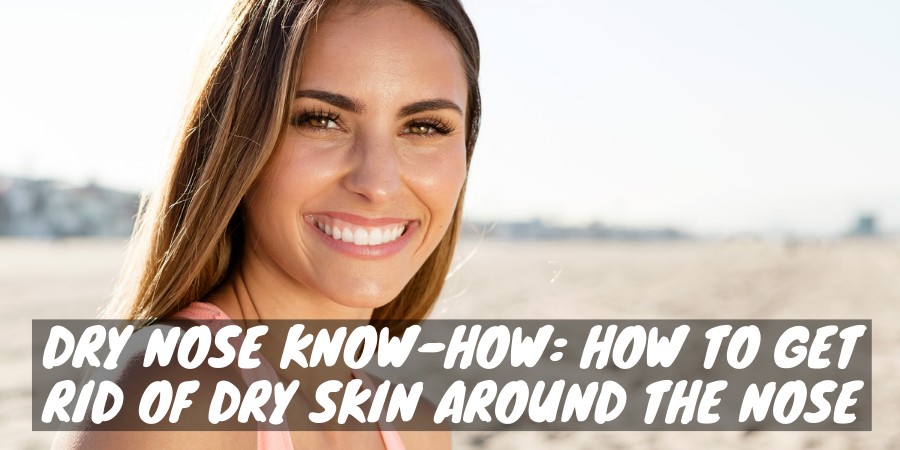It doesn’t seem to matter what you slather onto it or how delicately you treat it — that dry skin around your nose just won’t go away.
The redness, flakiness and roughness are getting on your last nerves. It’s time to find out how to get rid of them once and for all.
We’re here to help you find out what’s causing the dry skin around your nose, then show you the best way to make it beautiful again.
What Causes Dry Skin Around the Nose?

Exposure to the Environment
There’s something to love about every season and every type of weather.
But for your skin, some environmental factors are simply too much to handle.
Winter, for instance, brings with it cold, dry wind that saps the moisture from your skin.
Summertime isn’t much better: spending all of your time sitting next to an air conditioner dries your skin out, too.
Cities are full of smog, smoke and polluted air, which throw your skin off-balance and cause everything from clogged pores to flaky patches.
And out in the country, pollen and other allergens send your histamines into overdrive, causing dry skin. The constant nose-blowing doesn’t help, either!
Your dry skin may not be the result of poor skincare or inadequate products. It could very well be due to the climate and environment you spend your time in.
Sun and UV Damage
We all know the dangers of sun exposure. Those powerful UV rays, if left to their own devices, cause DNA mutations and eventual skin cancer.
But there are also short-term effects of sun exposure that aren’t talked about as often, particularly dry skin.
When the sun beats down on your skin, it dehydrates your skin cells and causes peeling and irritation.
The result: itchy, red, flaky skin that’s so sapped of moisture that it loses the ability to heal itself.
Medical Skin Conditions
Certain skin conditions can cause the skin around your nose to become dry and flaky.
Rosacea’s most prominent symptom is dryness of the nose and cheeks. Psoriasis and atopic dermatitis can also cause dry skin on and around your nose.
Some conditions, like seborrheic dermatitis, can make your nose extremely dry while making other parts of your face, like your forehead, overly oily.
And eczema, one of the most common skin conditions, can dry out any part of your body. One of the most common areas it effects is, you guessed it, the nose.
How to Get Rid of Dry, Flaky Skin Around the Nose

Make Sure to Moisturize
Your skin’s oil glands serve an important purpose: producing a moisture barrier to prevent water from evaporating out of your skin.
But if the skin around your nose is dry, it likely lacks enough oil glands to produce an adequate barrier.
This creates a cycle of dryness that’s easy to get stuck in. Your skin is too dry to prevent itself from drying out, and the problem just gets worse and worse.
That’s why it’s important to supplement your natural skin barrier with a moisturizer. Moisturizers contain emollients like squalene and cocoa butter to help your skin retain moisture and break the dryness cycle.
Most dermatologists recommend using two different moisturizers: a light one in the morning and a rich one at night. The light moisturizer lets the skin around your nose breathe without drying out, while the rich one soothes and toughens up your skin while you sleep.
Prioritize Hydration
Moisturizing won’t do you much good if your skin doesn’t have enough water to begin with.
Dehydration and dryness are two separate things, but they often go hand-in-hand. Dry skin lacks a moisture barrier, while dehydrated skin lacks moisture altogether.
Keep your skin hydrated by drinking at least eight glasses of water a day. If you’re taller, larger, or more active, you may need even more to stay adequately hydrated.
And if you find that your skin is still thirsty even though you drink plenty of water, try using products that contain humectants. Glycerin, hyaluronic acid and AHAs all transport water to your skin cells, letting you easily target your driest areas.
Use a Calming Cream During Winter
Winter can be rough on the mind and body, including the skin.
But you can soothe the dry skin around your nose by giving it the gift of relaxation.
A calming cream is typically packed with antioxidants to reduce irritation, humectants to restore hydration and vitamins to stimulate cell healing. They also contain natural oils that smell luscious while building up your moisture barrier.
When you come inside from the cold, apply the calming cream to your nose for instant relief and much-needed moisture.
Skip Harsh Products and Use Recovery Cream Instead
If your skin is dry, it can be tempting to bring out the big guns to get it under control.
But harsh skincare products are actually the last things you want to put on your dry nose.
That’s because harsh ingredients tend to dry the skin out even more. The biggest offenders are retinols, harsh cleansers and chemical exfoliants like salicylic acid.
All of these products sap the moisture from your skin, making your dryness problem even worse.
To combat dry skin, switch to gentle cleansers and reduce or cut out chemical exfoliants. And after cleansing, immediately apply a hydrating recovery cream to your face to instantly restore moisture and prevent irritation.
Run a Humidifier in Your Room

If the air in your home is dry, it won’t matter which products you use or which treatments you perform. You’ll get sent back to square one every time you walk in the door.
But there’s a simple solution: running a humidifier in the areas where you spend the most time.
Single-room humidifiers are inexpensive, readily available and easy to use. You can even purchase personal USB-powered humidifiers to boost the humidity in your office.
The ideal indoor humidity is between 30% and 50%. You can test the humidity in your home by measuring it with a hygrometer — if it’s under 30%, buy a humidifier and see how your skin thanks you!
Take It Easy with Physical Exfoliants
If your instinct when you see flaky skin is to exfoliate it away, it’s time to take a step back: you may be making the problem worse.
Too much exfoliation reduces your skin’s ability to heal itself. As soon as it starts repairing its damage, the scrub comes out again and forces it to start over.
This is especially common with physical exfoliants, which often cause tiny rips and tears in the skin. Frequent exfoliation prevents your skin from healing these microscopic injuries, exacerbating any dryness present.
Most dermatologists recommend exfoliating once or twice a week. Those with oily skin can exfoliate more often, but if you have dry skin, try cutting back and see the difference it makes in your skin.

